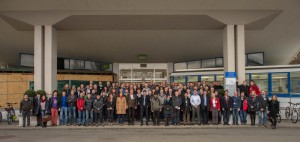
The CLIC workshop most frost-resistant participants enduring a very cold outdoor photo-session. Image: ©2015 CERN
The 2015 CLIC workshop took place at CERN from 27 to 30 January 2015, covering accelerator as well as detector and physics studies. With more than 260 participants and more than 200 talks the meeting was both well attended and full of interesting new results.
The week was built around an open high-energy frontier session filling up CERN’s main auditorium. Furthermore there were accelerator sessions focusing on collaboration efforts and plans for 2015-2019, a special session for high-gradient applications for free electron lasers (FELs), for industry and for medical applications, physics and detector sessions on current and future activities and finally the Collaboration and Institute Board meetings.
As usual the meeting also provided an opportunity to make up status for 2014 and compare the goals at the beginning of the year. Some of the main points are summarised in the following paragraphs.
The ‘rebaselining’ of the CLIC machine parameters for cost and power performance gains, also targeting stages as needed for initial Higgs and top measurements, was pursued throughout 2014 and is now being completed. The tools used to optimise the parameters of the machine in terms of cost and power remain available if further changes and optimisation will be needed once LHC results at 13-14 TeV are available. Power-reduction studies beyond the ongoing parameter optimisation efforts are focusing on key components where changes might have a large impact, for example the drive and main beam magnets and radiofrequency (RF) power systems.
By the end of 2014, three klystron-based X-band test facilities at CERN have become operational and have successfully been used for accelerating structure conditioning and operation. One more facility is being prepared for operation in 2015. This represents an increase in capacity by a factor of three for structure evaluation. The interest in the use of the CLIC technology is rapidly increasing, for example for use in FEL linacs. Several collaboration partners are considering extension of existing linacs or new compact FEL linacs making use of the high gradients achievable with X-band technology. For CLIC, this could substantially increase the overall industrial basis for X-band and high-gradient technology.
The CLIC Test Facility (CTF3) measurements have established the two-beam acceleration principle as well as the most central drive-beam performance and deceleration parameters. During 2013, a first complete mechanical main linac module was constructed and measured in the laboratory and in 2014 a complete two-metre CLIC module, currently 50% equipped, has been installed in CTF3 and performance tests are now starting. The demonstrations of beam-based alignment and emittance preserving methods have been further developed in the FACET facility at SLAC including important verifications of the CLIC wakefield models. The collaborative effort with light source laboratories related to low-emittance rings have developed further in 2014, involving ALBA, ANKA, CesrTA and ALS to mention some.
The development programme for high-efficiency RF sources, modulators and klystrons, including studies and specification towards procurement of prototypes has been fully defined in 2014. Many collaborating institutes are now involved and industrial studies are well underway. Other technical developments related to beam instrumentation, magnet prototypes, vacuum studies, control systems, alignment and stability are progressing well with contributions from many institutes. These technical developments address key technical performance challenges, are needed for system-test measurements, or are linked to power/cost reduction studies.
The common work with ILC has continued in areas such as civil engineering studies, RF power input couplers and cavity tuners, beam delivery systems/ATF studies at KEK, sources and damping rings. Two new collaboration partners, SINAP Shanghai and IPM Tehran, have joined in 2014 bringing the total number of collaborating institutes in the CLIC accelerator studies to 50 in 25 countries.
The CLIC detector and physics (CLICdp) studies are carried out by the twenty-five CLICdp institutes in close co-operation with the CALICE and FCAL collaborations, and with ILC studies. A comprehensive set of Higgs benchmark studies was completed in 2014, providing estimates of accuracies on Higgs couplings at different CLIC energy stages. Beam tests were carried out with various CLIC pixel detector assemblies and with a multi-layer CALICE and FCAL calorimeter prototypes. The pixel tests assessed the performance of thin sensors with new Timepix3 readout and AC-coupled assemblies of HV-CMOS active sensors and CLICpix readout. Engineering studies were performed on vertex detector supporting structures and air cooling. The data analysis of the scintillator hadron calorimeter with tungsten absorber plates was completed, providing detailed information on hadronic shower profiles. Good progress was made with a new optimised CLIC-specific detector design. At the same time, the simulations and reconstruction software is streamlined with a new geometry description package and a new all-silicon track reconstruction. Together with the new detector design it will form the basis for CLIC physics benchmark studies in the coming years.


Recent Comments